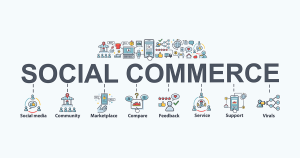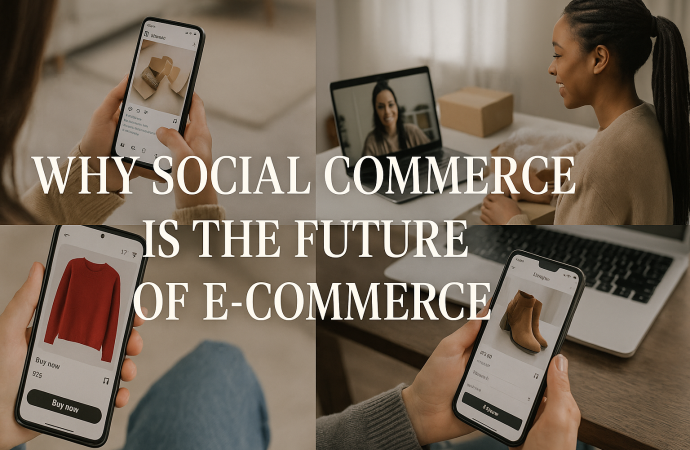Introduction Shopping habits have changed faster than ever in recent years. People now spend hours on social media each day, discovering new brands and products through friends, influencers, and targeted ads. Social commerce, which merges social media and online shopping, is the answer to this shift. Instead of visiting a separate website to make a
Introduction
Shopping habits have changed faster than ever in recent years. People now spend hours on social media each day, discovering new brands and products through friends, influencers, and targeted ads. Social commerce, which merges social media and online shopping, is the answer to this shift. Instead of visiting a separate website to make a purchase, customers can buy directly from apps like Instagram, TikTok, and Pinterest. This seamless experience boosts engagement, cuts down on friction, and drives sales. In 2025, social commerce is no longer an experiment—it’s the future of e-commerce. In this article, we explain what social commerce is and why it is growing so fast. We cover its key features, benefits for businesses and consumers, challenges and solutions, and future trends. We also include practical tips and a comparison table of top social selling platforms to help you navigate this new shopping frontier.
What Is Social Commerce?
Social commerce refers to the process of buying and selling products directly within social media platforms. Unlike traditional e-commerce, where a customer clicks an ad or searches Google, social commerce keeps the entire journey inside the social app. A shopper sees a post or a story, taps on a product link, and completes payment without leaving the platform. This model leverages shoppable content—images, videos, or live streams tagged with product details and “buy now” buttons.
How Social Commerce Differs from Traditional E-Commerce
Traditional e-commerce often starts outside social media. A prospective customer might read a blog, click a search result, or receive an email with a link to a brand’s site. With social commerce, discovery, consideration, and purchase happen within the same app. This reduction in steps lowers cart abandonment rates. Social commerce also capitalizes on social proof: likes, comments, and shares influence buying decisions. Friends’ recommendations and influencer endorsements appear right alongside product tags, making the shopping journey feel more like a conversation than a transaction.
Why Social Commerce Is Growing

Image by: Yandex.com
Several key factors fuel social commerce’s rapid ascent.
Increased Mobile Usage
Smartphones are the primary device for social media. Mobile-friendly shopping experiences that avoid cumbersome redirects align perfectly with on-the-go browsing habits. When customers can complete purchases with a few taps, conversion rates climb.
Influence of User-Generated Content
Consumers trust real users more than polished ads. Social commerce platforms highlight user-generated reviews, unboxing videos, and testimonials directly in the purchase flow. This social proof drives confidence and spurs impulse buys.
Advertising Evolution
As ad fatigue grows, brands seek new ways to reach audiences. Shoppable posts and in-app storefronts combine organic and paid reach. Ads can tag products directly, letting interested users buy instantly without extra steps.
Rise of Live Shopping
Live shopping—real-time video streams where hosts showcase products and interact with viewers—has exploded in markets like China. These events blend entertainment and commerce, creating urgency with live chat and flash deals. Western platforms like Instagram Live and TikTok Live are adopting similar formats, driving social commerce forward.
Five Reasons Social Commerce Beats Classic E-Commerce
1. Discovery Feels Organic
Feeds serve content based on interests. A skincare reel appears next to dog videos, making the product look like a genuine recommendation rather than an ad.
2. Social Proof in Real Time
Comments, likes, and shares act as live reviews. Buyers trust peer validation more than polished landing pages.
3. Frictionless Checkout
Native wallets—Shop Pay, Apple Pay, TikTok Shop Payment—remember shipping details, so the full transaction ends in under 20 seconds.
4. Algorithmic Targeting
Platforms know user behavior at micro levels. Sellers run small-budget campaigns that hit exact niches—“men 25-34 who follow hiking, live in Denver, and saved a tent post”—boosting return on ad spend.
5. Creator-Led Content Outsells Banner Ads
Influencers produce engaging, authentic videos instead of static product shots. A 2025 Shopify study shows creator posts drive conversion rates of 4-6 %, double typical e-commerce averages.
Key Social Commerce Features

Image by: Yandex.com
Understanding core features helps businesses and consumers make the most of social commerce.
Shoppable Posts and Stories
Brands create posts with embedded product tags. A user tapping a tag sees price, size options, and a “Buy Now” button. Stories add time-limited product stickers that link directly to checkout pages.
In-App Checkouts
Payments happen inside the social app. Platforms like Instagram and Facebook offer native checkout services that store user payment data securely. This avoids redirecting users to external sites and reduces abandoned carts.
Live Shopping Events
Brands host live streams where hosts demonstrate products, answer questions, and share exclusive offers. Viewers can click product links embedded in the video without leaving the stream. This format drives real-time engagement and high conversion rates.
Social Proof and Community Engagement
Likes, comments, and user-generated content fuel trust. Platforms display reviews and ratings next to product tags. Community features like polls and Q&A stickers let shoppers engage directly with brands and influencers.
AI-Powered Recommendations
Machine learning analyzes browsing and purchase data to suggest products in feeds and storefronts. Personalized recommendations appear as “You might like” or “People also bought,” increasing average order values.
Benefits for Businesses

Image by: Yandex.com
Adopting social commerce yields clear payoffs for brands and retailers.
Higher Conversion Rates
By reducing steps from discovery to purchase, businesses see lower abandonment and higher sales. In-app checkouts and one-tap buys remove friction.
Cost-Effective Marketing
Shoppable organic posts reach followers without ad spend. When boosted, these posts blend paid and organic reach, making advertising budgets more efficient.
Enhanced Customer Insights
Social commerce platforms provide data on views, taps, and purchases at a granular level. Businesses learn which products drive engagement, which social content converts, and how shoppers move through funnels.
Direct Customer Engagement
Brands talk directly to shoppers via comments, direct messages, and live chat. This real-time engagement builds relationships and loyalty, leading to repeat purchases and word-of-mouth growth.
Benefits for Consumers
Shoppers also gain advantages from social commerce innovations.
Seamless Shopping Experience
With no need to switch apps or re-enter payment details, buying a product is faster and more intuitive. Social commerce feels like a natural extension of browsing.
Authentic Recommendations
Seeing friends’ likes, influencer demos, and real customer reviews in context boosts confidence. Social commerce leverages community trust to guide purchasing decisions.
Exclusive Offers and Flash Sales
Live events and story stickers create urgency with limited-time deals. Consumers enjoy early access, unique bundles, and flash discounts that traditional e-commerce may not provide.
Personalized Shopping
AI-driven recommendations and curated live events align with individual tastes. Shoppers discover new products seamlessly within feeds they already scroll through daily.
Challenges and Solutions

Image by: Yandex.com
Despite its promise, social commerce faces several hurdles.
Fragmented Platform Ecosystem
Each social network has its own tools and rules. Managing multiple storefronts and tech integrations can overwhelm small businesses.
Solution: Use an omnichannel commerce platform that centralizes storefront management and syncs inventory and analytics across networks.
Data Privacy Concerns
In-app payments and tracking raise privacy questions. Shoppers worry about sharing payment details on social platforms.
Solution: Choose platforms with robust encryption and transparent privacy policies. Clearly communicate data practices to build trust.
Customer Service Complexity
Instant purchases often lead to immediate questions about returns or shipping. Brands must support real-time chat and prompt responses.
Solution: Implement AI-driven chatbots for common queries and dedicate staff to monitor social channels and live events.
Measuring ROI
Attributing sales directly to social commerce can be tricky, especially when sales occur via multiple touchpoints.
Solution: Use UTM codes, pixel tracking, and platform analytics to capture the full customer journey and assign credit accurately.
Future Trends in Social Commerce

Image by: Yandex.com
Looking ahead, social commerce will continue to evolve with several emerging trends.
Augmented Reality Shopping
AR filters let shoppers virtually “try on” clothes, accessories, or see furniture in their rooms. Integration of AR with shoppable posts will boost confidence and reduce returns.
Conversational Commerce
Chat-based shopping via chatbots and messaging apps will expand. Customers can browse catalogs, ask questions, and check out—all within a chat.
Creator-Led Mini-Stores
Influencers will host fully branded micro-stores within social platforms. Fans can shop entire curated collections from their favorite creators, blurring lines between content and commerce.
Social Commerce for B2B
Businesses will adopt social commerce features to sell wholesale or professional services directly through LinkedIn and other networks, tapping into decision makers in professional contexts.
Comparison Table of Top Social Commerce Platforms
| Platform | Shoppable Features | Checkout Options | Live Shopping Support | Fees/Commissions |
|---|---|---|---|---|
| Shoppable posts, stories | In-app checkout, linkouts | Live shopping, badges | 5% per sale | |
| TikTok | Shoppable tags, banner ads | Linkouts, partner checkouts | TikTok Live Shop | Varies by region |
| Shop tabs, carousel ads | In-app checkout, website | Live shopping events | 5% per transaction | |
| Product pins, idea pins | Linkouts, Shop grid | Soon-to-launch live | 2% per checkout | |
| Snapchat | Collections, AR try-on | Linkouts | Live shopping (beta) | 0–6% per sale |
Conclusion
Social commerce is more than a trend—it is reshaping the future of e-commerce by merging discovery, engagement, and purchase into a single seamless experience. Brands enjoy higher conversion rates, deeper customer insights, and cost-effective marketing. Shoppers benefit from authentic recommendations, exclusive deals, and frictionless checkouts. While challenges like data privacy and platform fragmentation persist, practical solutions and emerging technologies such as AR and conversational commerce promise to drive social commerce forward. As social networks continue to innovate, businesses that embrace social commerce now will lead the next wave of digital shopping.
Call-to-Action: Ready to capitalize on the social commerce revolution? Evaluate top social selling platforms, set up your shoppable storefront, and start engaging customers where they already spend their time today!
















